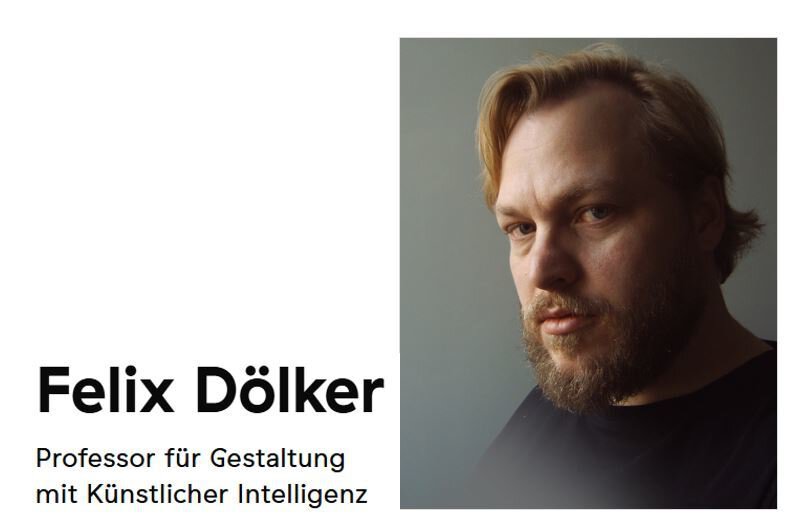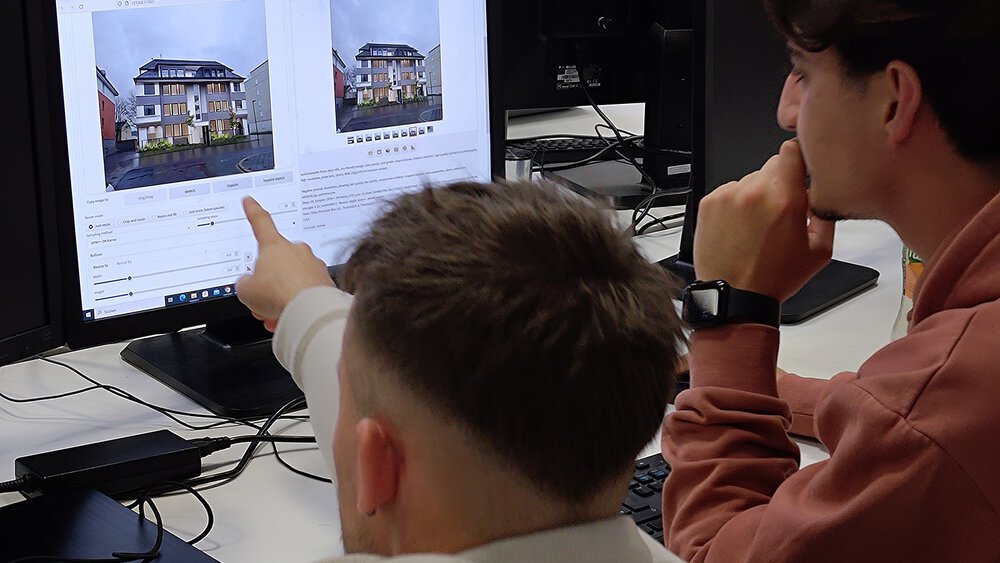Between algorithm and quality: Rethinking design!
Interview with Prof. Felix Dölker, Professor of Design with AI at Mainz University of Applied Sciences
Prof Felix Dölker is a communication designer and Professor of Design with Artificial Intelligence at Mainz University of Applied Sciences. He also teaches at several universities in the fields of architecture, design and media. His research and teaching focusses on the effects of AI-supported tools on design processes. As managing partner of the schunck dölker agency in Darmstadt, he combines design practice with technological reflection. As First Chairman of the Deutscher Werkbund Hessen, he is also committed to the future of design between tradition and innovation.
In this interview we talk to Felix Dölker about the influence of artificial intelligence on design and teaching. He explains why AI not only brings new tools, but also requires a new understanding of quality and responsibility. In conversation, it becomes clear that good design needs more than just technology—it depends on attitude, reflection and craftsmanship.

Mr Dölker, how did you become interested in artificial intelligence (AI) in the first place? Was it more of an intrinsic motivation or was there a special moment?
Felix Dölker: I don't come directly from architecture, but from communication design. Machine learning was hardly a topic in design for a long time. Nevertheless, even before the hype, I was already intensively involved with the question of what lies ahead. I am driven by a deep curiosity—and the clear realisation that something big is coming and that we don't have years to react to it. Many people underestimate how rapid this transformation really is. If someone says today that they want to deal with AI ‘one day’, it seems almost naive, because AI is already changing our working world. I also see it as my responsibility to bring this topic back into teaching. After all, the world in which students graduate today is different from the one in which they started their studies. It would be negligent not to prepare them for this.
What a stroke of luck to be able to use the exchange via the university network in the other departments to really grasp the potential and scope of AI!
Felix Dölker: Absolutely. Everyday office life often offers little room for a fundamental examination of new technologies. Universities, on the other hand, offer precisely this space for reflection, exchange and experimentation. Smaller offices in particular often lack the time and resources to deal with this systematically. The big players are already investing massively—both in terms of personnel and technology. This creates new competitive situations for which smaller players are barely prepared. AI actually has democratising potential—but only if access is low-threshold and knowledge is shared.
The concept of quality is a central point of reference for my discussion of AI in design. Originally, it simply describes the nature of a thing, but in design processes it describes much more: atmosphere, effect and context. Precisely because the term is so multi-layered and charged, it is ideally suited to use its definition to negotiate the question of what constitutes good design today—especially at a time when AI suggests that quality can simply be generated by prompt.
What specifically is AI changing in the design process?
Felix Dölker: A lot. We have to learn to communicate even more precisely, for example through well-formulated prompts or specialised workflows. This forces us to formulate our design intentions clearly. At the same time, there is a danger of being satisfied too quickly, as AI always produces results that at least seem plausible. In doing so, we could lose our willingness to engage with quality and context. However, good design is more than just an appealing image, as it requires judgement, experience and reflection.
So do you still have to master the tools of the craft industry?
Felix Dölker: Absolutely. AI often seems like a closed universe with infinite yet limited possibilities. That sounds paradoxical, but it harbours the risk of submitting to these limits when designing. That is dangerous. We need the craft of design in order to maintain a sense of materiality, context and relevance. I learnt lead typesetting during my studies—not because it is still relevant in practice today, but because it changes our understanding of typography. Such experiences are important in order to find an authentic approach to design. However, knowledge of limitations is essential for successful design, because only those who recognise limitations can develop a sound understanding of quality.
AI can simplify many things, but it does not release us from the responsibility of making our own decisions and taking a genuine stance. In the Japanese practice of Suiseki, curating itself becomes an art form: a stone is consciously selected and staged based on its shape - not because it is the ‘best’, but because it is given meaning through its selection and context. This attitude shows that design is not only about creating, but also about deciding.
How do you experience the use of technology in everyday practice and what would help to make access easier?
Felix Dölker: Many people experience digital systems as a black box. Even in a professional context, they often lack a basic understanding of technology. Those who only consume digital tools but do not understand what happens behind them lose the ability to deal with them critically. If you really want to utilise the possibilities of technology, you have to be prepared to get to grips with the basics—regardless of age or professional background. Workshops, dialogue and joint exploration are wonderful ways to do this. Many people only understand what the technology can do—and what it can't - by doing it. Without these initial ‘aha’ experiences, it remains abstract and often frustrating. Technology must not be an end in itself, but should enable design, not replace it.
What would you recommend as a first step in dealing with AI?
Felix Dölker: The most important step is to get started. You shouldn't wait and see, but try things out, reflect and exchange ideas with others. Whether in the office, in a team or in networks—you learn faster together. It is important to take responsibility: for the use of the tools, for the results and for not accepting everything uncritically. AI can speed up processes, but it does not replace thinking. It's about designing with technology instead of just working with it.
In a world full of possibilities, it is not only what we design that matters, but also what we consciously leave out. Vilém Flusser puts it in a nutshell: ‘The apparatus does what people want, but people can only want what the apparatus can do.’










